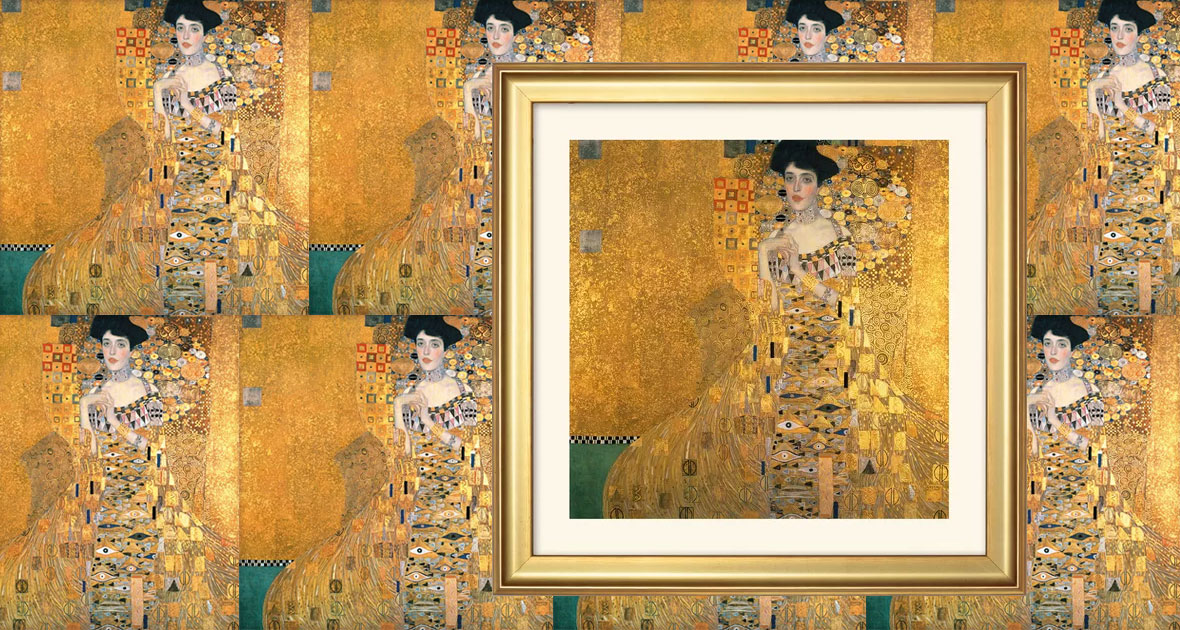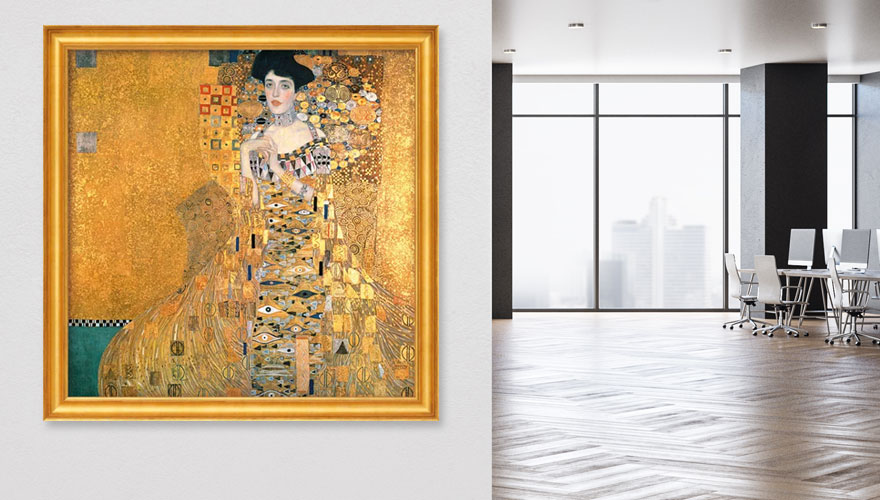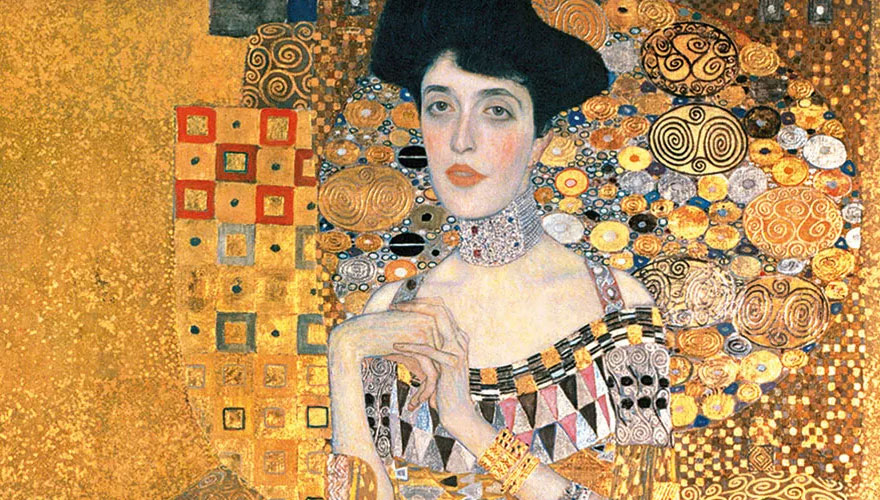
"Adele Bloch-Bauer I" - A Masterpiece of Beauty
Gustav Klimt's famous painting "Adele Bloch-Bauer I" is not only an impressive example of the artist's skills and distinctive style but also a testament to the importance of art and history in our world.
Gustav Klimt's "Golden Adele"
Gustav Klimt's "Adele Bloch-Bauer I" is undoubtedly one of the most fascinating works of the Austrian artist. Klimt created the impressive painting, also known as the "Golden Adele," between 1903 and 1907 on a 138 x 138 cm canvas. The motif portrays a glamorous and wealthy Jewish woman named Adele Bloch-Bauer. She was a symbol of beauty and elegance in the early 20th century, an important figure in Viennese society, and a significant patron of Klimt's art.
The painting is an outstanding example of Klimt's "Golden Phase", which had a significant impact on the Viennese Art Nouveau, showcasing the impressive use of gold in art. Adele is depicted wearing a golden gown adorned with geometric patterns and flowers. In addition, stylised eyes are noticeable on the robe, which are reminiscent of all-seeing eyes. A jewellery piece with silver stones and diamonds fully covers her neck.
The gold tones dominate the portrait, blending perfectly with the opulent ornaments and patterns, creating a breathtaking symmetry in the painting. Gustav Klimt's unique style and use of gold leaf make "Adele Bloch-Bauer I" unmistakable. "Adele Bloch-Bauer I" is an exemplary work of Klimt's opulent character and his ability to merge the beauty of the human body with decorative elements.

The Turbulent History Klimt's Masterpiece: Loss and Return of “Adele Bloch-Bauer I”
It is not only the breathtaking beauty of the Adele that makes Klimt's painting so special but also its turbulent history. In 1903, Gustav Klimt, one of the leading artists of the Viennese Art Nouveau movement at the time, received a commission from Ferdinand Bloch-Bauer to paint a portrait of his wife, Adele. After producing hundreds of sketches, Klimt completed the painting in 1907.
When Adele died in 1925 at the age of only 43, her husband Ferdinand inherited the famous painting. However, in 1938, he was forced to leave his wife's painting behind when he had to flee his home country of Austria due to the Nazi takeover. The National Socialists renamed the painting "The Woman in Gold" to disguise its Jewish origin and handed it over to the State Gallery Belvedere.
Even years after World War II, the State Gallery Belvedere refused to return the artwork to the rightful heirs of the Bloch-Bauers. It was only after a lengthy legal battle that the painting was returned to its rightful heir, Maria Altmann, in 2006, and it is now an important attraction in the Austrian Gallery Belvedere in Vienna.
Who Was Adele Bloch-Bauer?
Adele Bauer was born in Vienna in 1881 as a daughter of a wealthy Jewish family. As a young woman, at the age of 18, she married significantly older industrialist Ferdinand Bloch. The Bloch-Bauer couple, part of the Jewish bourgeoisie in Vienna, shared a passion for art and were known for their impressive art collection.
Adele supported numerous artists and contributed to the development of the Viennese art scene. This is how Adele Bloch-Bauer and Gustav Klimt met around 1900. It was the beginning of a lifelong friendship that primarily involved artistic collaboration.
Adele's prominent position in Viennese society and her engagement in the arts made her an essential patron, supporting Klimt in the creation of significant works. However, Adele Bloch-Bauer's contribution to Klimt's art was not limited to her support behind the scenes; she also served as his muse and was the only woman he portrayed twice, in the works "Adele Bloch-Bauer I" (1907) and "Adele Bloch-Bauer II" (1912).

The Woman in Gold by Klimt: Beauty as Symbolism
The "Adele Bloch-Bauer I" painting, created in the course of Klimt's "Golden Phase", is of particular cultural and historical importance because of its exceptional beauty. The work shows Adele as an important patron of the artist, radiating beauty and elegance. Klimt presented Adele Bloch-Bauer in a regal and imposing manner, emphasising her social status and role in Viennese society.
The richly adorned dress and jewellery, such as the necklace studded with silver stones and diamonds, underscore her elevated social standing. The colours used by Klimt, such as bronze, silver, and gold, create extraordinary beauty that fascinates all observers. The use of gold leaf also symbolises wealth and luxury.
However, Klimt's depiction of Adele's hands, unnaturally interlaced, gives the painting a mysterious character. This pose suggests tension, contradicting her seemingly perfect appearance and beauty. Even today, art historians speculate about this ambiguity, which may never be fully resolved.
Klimt's "Golden Adele" - A Work of Art Nouveau or Modernism?
Gustav Klimt was one of the most important artists of the Viennese Art Nouveau movement. However, there is some debate as to whether Klimt's "Golden Adele" can truly be considered an Art Nouveau work, as some art experts identify elements of Modern Art movements, such as Expressionism and Abstraction, in this painting. Nevertheless, the majority of the art world believes that the painting perfectly fits into Klimt's typical Art Nouveau style and, thus, into his overall oeuvre.
Ultimately, it cannot be denied that Klimt combined traditional and modern artmaking the transition to modern art and having a major influence on its development. For example, the use of gold and geometric shapes influenced the modern art world and inspired many artists. In the late 19th-century art world, traditional painting conventions were prevalent, but Klimt introduced an innovative approach with his unique aesthetics and style.
"Adele Bloch-Bauer I" is a masterpiece inspired by ornamentation and nature. Klimt used typical Art Nouveau characteristics, such as a love for ornamentation and a preference for flat surfaces and contours, to create a unique aesthetic and imagery. The golden surroundings and floral motifs in his "Golden Adele" merge harmoniously, showcasing his ability to combine beauty and elegance in his distinctive imagery while emphasising the significant role of women in art.
The “Adele Bloch-Bauer” Painting Sparks Many Controversies Even After More Than 100 Years
One of the greatest controversies concerns the still unresolved question of whether Adele Bloch-Bauer and Gustav Klimt had a secret romantic affair. Klimt was known for maintaining close and intimate relationships with some of his female models, but there is no reliable evidence proving a romantic relationship between him and Adele.
Some art experts point to Klimt's "Judith and Holofernes" from 1901 as another possible painting for which Adele posed as a model. Not only are the faces of the female figures in both paintings strikingly similar, but both models also wear distinctive gold necklaces.
In Klimt's "Adele Bloch-Bauer I" painting itself, there are hints of an intimate relationship between Klimt and Adele. The sensuality conveyed in the portrait suggests an intimate connection between the artist and the model. Additionally, the use of colours, such as the delicate blue on her collarbone and the red on her cheeks, implies an erotic connection.
Despite this controversy, "Adele Bloch-Bauer I" remains a masterpiece of art history, fascinating not only for its beauty but also for its tumultuous history.
